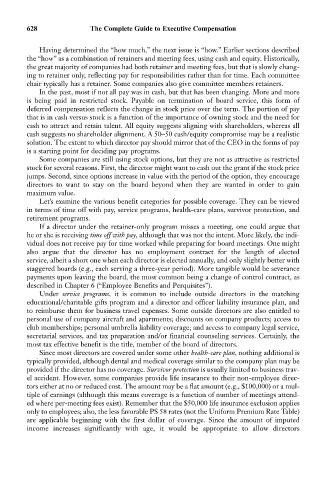Page 643 - Bruce Ellig - The Complete Guide to Executive Compensation (2007)
P. 643
628 The Complete Guide to Executive Compensation
Having determined the “how much,” the next issue is “how.” Earlier sections described
the “how” as a combination of retainers and meeting fees, using cash and equity. Historically,
the great majority of companies had both retainer and meeting fees, but that is slowly chang-
ing to retainer only, reflecting pay for responsibilities rather than for time. Each committee
chair typically has a retainer. Some companies also give committee members retainers.
In the past, most if not all pay was in cash, but that has been changing. More and more
is being paid in restricted stock. Payable on termination of board service, this form of
deferred compensation reflects the change in stock price over the term. The portion of pay
that is in cash versus stock is a function of the importance of owning stock and the need for
cash to attract and retain talent. All equity suggests aligning with shareholders, whereas all
cash suggests no shareholder alignment. A 50–50 cash/equity compromise may be a realistic
solution. The extent to which director pay should mirror that of the CEO in the forms of pay
is a starting point for deciding pay programs.
Some companies are still using stock options, but they are not as attractive as restricted
stock for several reasons. First, the director might want to cash out the grant if the stock price
jumps. Second, since options increase in value with the period of the option, they encourage
directors to want to stay on the board beyond when they are wanted in order to gain
maximum value.
Let’s examine the various benefit categories for possible coverage. They can be viewed
in terms of time off with pay, service programs, health-care plans, survivor protection, and
retirement programs.
If a director under the retainer-only program misses a meeting, one could argue that
he or she is receiving time off with pay, although that was not the intent. More likely, the indi-
vidual does not receive pay for time worked while preparing for board meetings. One might
also argue that the director has no employment contract for the length of elected
service, albeit a short one when each director is elected annually, and only slightly better with
staggered boards (e.g., each serving a three-year period). More tangible would be severance
payments upon leaving the board, the most common being a change of control contract, as
described in Chapter 6 (“Employee Benefits and Perquisites”).
Under service programs, it is common to include outside directors in the matching
educational/charitable gifts program and a director and officer liability insurance plan, and
to reimburse them for business travel expenses. Some outside directors are also entitled to
personal use of company aircraft and apartments; discounts on company products; access to
club memberships; personal umbrella liability coverage; and access to company legal service,
secretarial services, and tax preparation and/or financial counseling services. Certainly, the
most tax effective benefit is the title, member of the board of directors.
Since most directors are covered under some other health-care plan, nothing additional is
typically provided, although dental and medical coverage similar to the company plan may be
provided if the director has no coverage. Survivor protection is usually limited to business trav-
el accident. However, some companies provide life insurance to their non-employee direc-
tors either at no or reduced cost. The amount may be a flat amount (e.g., $100,000) or a mul-
tiple of earnings (although this means coverage is a function of number of meetings attend-
ed where per-meeting fees exist). Remember that the $50,000 life insurance exclusion applies
only to employees; also, the less favorable PS 58 rates (not the Uniform Premium Rate Table)
are applicable beginning with the first dollar of coverage. Since the amount of imputed
income increases significantly with age, it would be appropriate to allow directors

